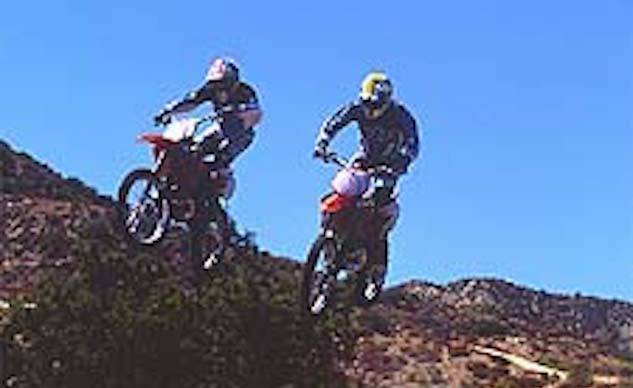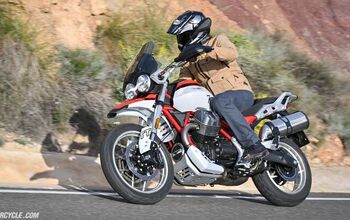Church of MO: 2001 KTM Roll-Out
Rather hard to believe that KTM didn’t build its first street motorcycle until 1996 – the Duke 620. Since then, the Austrians have built so many excellent Dukes, RC sportbikes, and great adventure motorcycles it’s hard to remember the time before. Today we look back 20 years to when the orange brand decided to make a push into the world of motocross. It took them a while to get there, but they did achieve three Supercross titles in a row with Ryan Dungey, 2015 through 2017. An Easter reading from the book of Kato.
Austria’s Assault Force Arrives!
manufacturer of off-road/enduro motorcycles (a memory of the days when John Penton first imported the bikes to meet his particular needs for enduro bikes, no doubt).KTM hopes to change that perception via a large-scale remarketing effort. You saw an initial stage of that in this year’s AMA/EA Sports Supercross Series as well as the AMA/Chevy Trucks U.S. Motocross Championships. While KTM has always made motocross bikes, it’s never really been well-known and popular in the U.S. as a major player in the MX market.
It remained one of those quaint European companies, too small to make a wave in the oceans of Japanese bikes that dominated tracks on these shores. That’s changing.
As the giant orange KTM 18-wheeler at all AMA Pro Racing events testifies, KTM has made motocross in America a priority. It’s only fair, of course, since Americans are the leading consumer of its products, which now number 30! That’s even more impressive when you consider that all but five are pure dirt models, including the built-on-order 660 Rally intended strictly for races like the Dakar Rally. KTM is obviously heavily into dirt bikes and racing.
But motocross? Believe it!
Last year, KTM broke from a long-standing tradition and began to take its motocross models on a different development path than the off-road racers. For the first time in company history, the SX motocross bikes will not simply be hot-rodded enduro bikes. Instead, they are bikes that are focused specifically on the unique requirements of motocross, which is how the Japanese pursue MX glory.
“KTM knows it’s going up against giants but believes it’s got what it takes. Based on our experiences, we tend to agree.”
For the first time ever, KTM recently made available every one of its motocross bikes for the enthusiast press.
After a brief technical overview of the line-up by KTM’s Scot Harden and Tom Moen, everyone got a chance to ride all five SXs at the Hungry Valley MX track near Gorman, California, just off I-5. It was a great day, the stuff dreams are made of.
Technically speaking, there are significant changes on just about every model, including the redesigned 400cc and 520cc thumpers. Incidentally, the factory is allotting substantially more of the hard-to-get-this-year four-strokes to eager Americans. This is good news. We’ll start small and work up. The 125 SX (being used to run away 1-2 in the 125 cc MX GPs as this is written) gets a slightly longer stroke, up to 54.5 mm from 54.
That makes it minutely undersquare at 54 x 54.5mm compared to the previous bore and stroke measurements of 54 x 54 mm. KTM’s goal here was to boost low-end, thus smoothing the transition to the already healthy midrange and class-leading top-end wallop.
“KTM leads the class’ manufacturers championship as well, all because of the success of the new Racing Four-Strokes.”
Complementing that update is a new piston, again with one ring (the E/XC piston sports a pair of rings); a lighter crank for quicker revving; revised porting and a narrower-profile, while the formerly plastic ignition cover is now powder-coated magnesium. The clutch cover will also be powder-coated to maintain its look longer. The 125 shares the mag cover with the 200 (the cases on both bikes are identical). A 12mm longer shift lever that sticks 6mm farther out, promises to provide easier access to the shifter and easier shifting. Frankly, KTM’s 250 SX has fallen short in the past, possibly hindered by its enduro heritage.
That may very well change now that KTM is consciously developing the SX and E/XC models independent of each other. In order to make the ’01 250 SX more aggressive in the motocross theater of battle, the engineers in Austria modified the exhaust porting, reshaped the combustion chamber, designed a lighter piston and remapped the digital ignition. They also sent the crankcase covers to the powder coater to preserve the good looks longer and incorporated the longer, easier-to-hit shift lever of the 125/200.
More by John Burns






























Comments
Join the conversation
20 years later and now KTM is one of the few motorcycle manufacturers developing 2-strokes. Bummer.